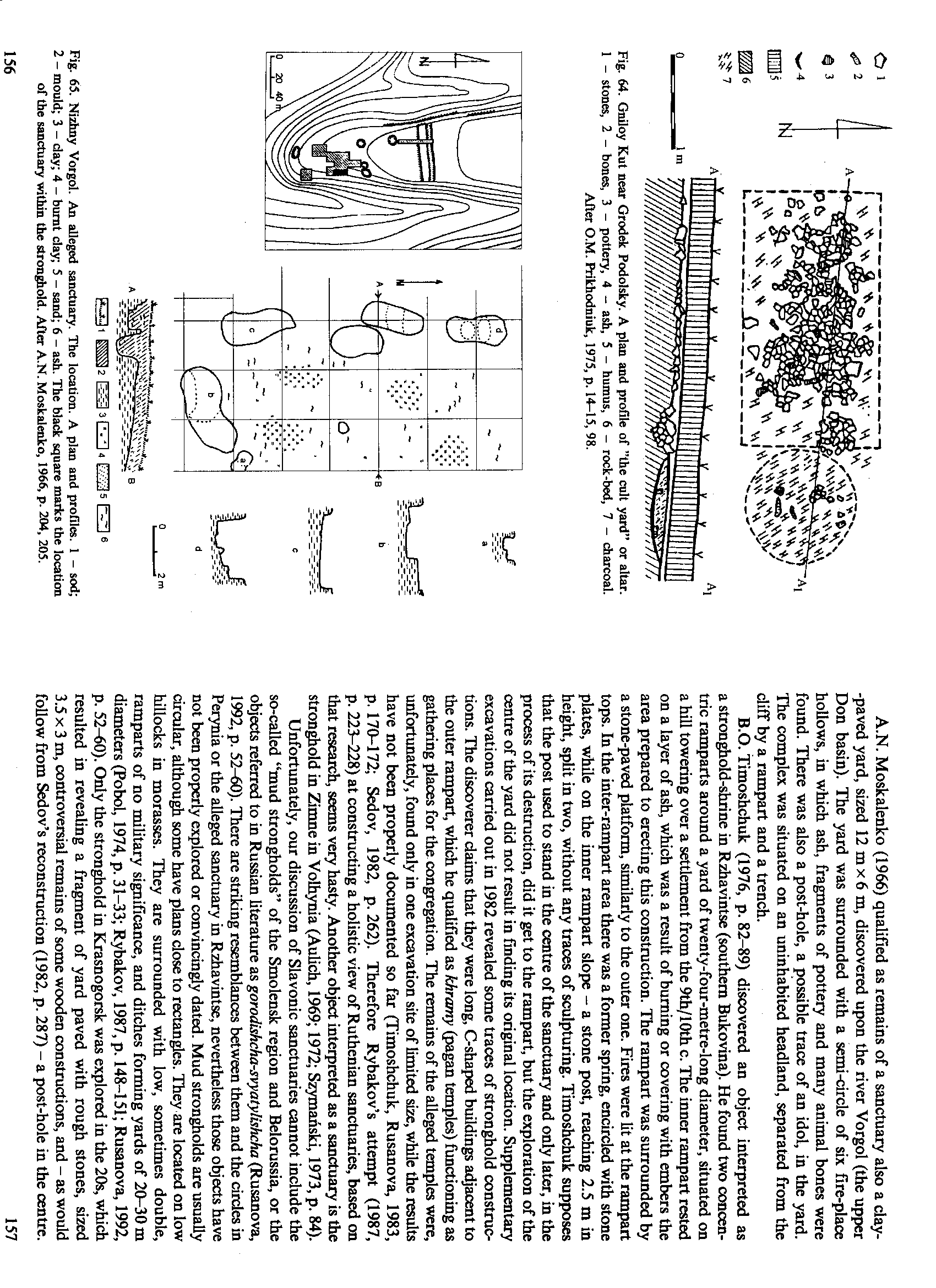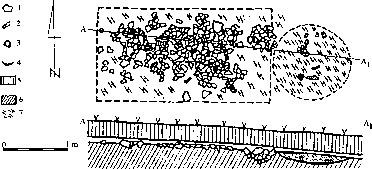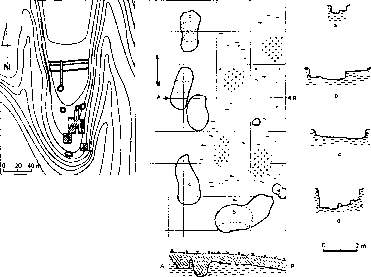image077


Fig. 64. Gniloy Kut near Grodek Podolsky. A plan and profile of ”the cult yard” or altar. 1 - Stones, 2 - bones, 3 - pottery, 4 - ash, 5 - humus, 6 - rock-bed, 7 - charcoal. After O.M. Prikhodniuk, 1975, p. 14-15, 98.

E391 ^^2 !-===-! 3 I ■ • ■ I 4 |-~~J 6
Fig. 65. Nizhny Vorgol. An alleged sanctuary. The location. A plan and profiles. 1 - sod; 2 - mould; 3 - day; 4 - burat clay; 5 - sand; 6 - ash. The black square marks the location of the sanctuary within the stronghold. After A.N. Moskalenko, 1966, p. 204, 205.
A. N. Moskalenko (1966) ąualified as remains of a sanctuary also a clay--paved yard, sized 12 m x 6 m, discovered upon the river Vorgol (the upper Don basin). The yard was surrounded with a semi-circle of six flre-place hollows, in which ash, fragments of pottery and many animal bones were found. There was also a post-hole, a possible tracę of an idol, in the yard. The complex was situated on an uninhabited headland, separated from the cliff by a rampart and a trench.
B. O. Timoshchuk (1976, p. 82-89) discovered an object interpreted as a stronghold-shrine in Rzhavintse (southem Bukovina). He found two concen-tric ramparts around a yard of twenty-four-metre-long diameter, situated on a hill towering over a settlement from the 9th/10th c. The inner rampart rested on a layer of ash, which was a resuit of buming or covering with embers the area prepared to erecting this construction. The rampart was surrounded by a stone-paved platform, similarly to the outer one. Fires were lit at the rampart tops. In the inter-rampart area there was a former spring, encircled with stone plates, while on the inner rampart slope - a stone post, reaching 2.5 m in height, split in two, without any traces of sculpturing. Timoshchuk supposes that the post used to stand in the centre of the sanctuary and only later, in the process of its destruction, did it get to the rampart, but the exploration of the centre of the yard did not resuit in frnding its original location. Supplementary excavations carried out in 1982 revealed some traces of stronghold construc-tions. The discoverer daims that they were long, C-shaped buildings adjacent to the outer rampart, which he ąualified as khramy (pagan temples) functioning as gathering places for the congregation. The remains of the alleged temples were, unfortunately, found only in one excavation site of limited size, while the results have not been properly documented so far (Timoshchuk, Rusanova, 1983, p. 170-172; Sedov, 1982, p. 262). Therefore Rybakov’s attempt (1987, p. 223-228) at constructing a holistic view of Ruthenian sanctuaries, based on that research, seems very hasty. Another object interpreted as a sanctuary is the stronghold in Zimne in Vo!hynia (Aulich, 1969; 1972; Szymański, 1973, p. 84).
Unfortunately, our discussion of Slavonic sanctuaries cannot include the so-called “mud strongholds” of the Smoleńsk region and Belorussia, or the objects referred to in Russian literaturę as gorodishcha-svyatylishcha (Rusanova, 1992, p. 52-60). There are striking resemblances between them and the circles in Perynia or the alleged sanctuary in Rzhavintse, nevertheless those objects have not been properly explored or convincingly dated. Mud strongholds are usually circular, although some have plans close to rectangles. They are located on Iow hillocks in morasses. They are surrounded with Iow, sometimes double, ramparts of no military significance, and ditches forming yards of 20-30 m diameters (Pobol, 1974, p. 31-33; Rybakov, 1987, p. 148-151; Rusanova, 1992, p. 52-60). Only the stronghold in Krasnogorsk was explored in the 20s, which resulted in revealing a fragment of yard paved with rough Stones, sized 3.5 x 3 m, controversial remains of some wooden constructions, Md - as would follow from Sedov’s reconstruction (1982, p. 287) - a post-hole in the centre.
157
Wyszukiwarka
Podobne podstrony:
image056 Fig. 40. Stara Kourim. A large hall building. A - a plan; B - a profile of the wali constru
image063 Fig. 47. Trzebiatów. A plan of the town and its surroundings. A - the cult place on David H
image002 Brian Aldiss is one the most influential -and one of the best - SF writers Britain has eve
image002 Photo: William Rotsler TERRY CARR has been acclaimed as one of the most important editors o
image003 Photo: Jay K. Klein Terry Carr has been acclaimed as one of the major editors of modern sci
skanuj0004 PARABOLA PF- PM Fig. 1 The axis, the width and depth ( or span and rise) of the parabola
288 Z. KORUBA ET AL. Fig. 4. (a) Time-dependent profile of the terrain unevenness (bump); (b) time-d
Scan0007 (36) 12 12 Fig.l: MS prevalence raiios in Europę, North Africa and Israel presented in this
Scan0007 (36) 12 12 Fig.l: MS prevalence raiios in Europę, North Africa and Israel presented in this
Essential Oils of Sagę Species 187 Fig. 1. Fingerprint gas chromalograms obtained from HS-GC-MS anal
image002 (141) ADVANCE PRAISE FORTHE BETRAYALGAME “Laced with authenticity and utter realism ...The
UNIT 8 Fig.6. The thorax during breathing: (A) inspiration, (B) cxpiration.RESPIRATION AND DISEASES
image106 Fig. 90. Ślęża. “The Boar”. The archives of the Institute of Archaeology and Ethnology of t
DSC07881 (3) 50CU* Fig. 5. Profile of the Uściąż dune (situation marked with letter “U” in Fig. 4) 1
DSC08236 (2) Eptatretus Petromyzon $qualus Fig. 3J. A. morphołogy and raterrelaiionships of the duce
image015 by the Rans in the times of Charlemagne, which was supposed to leave a tracę in the shape o
więcej podobnych podstron